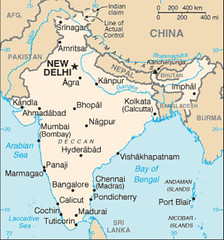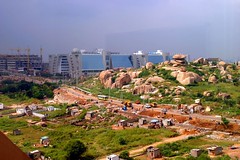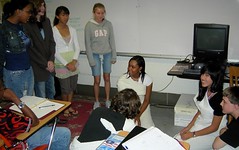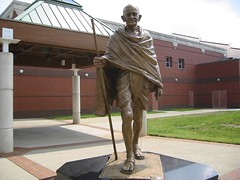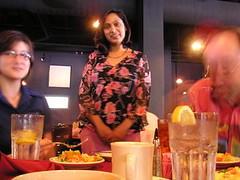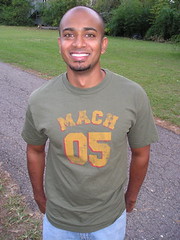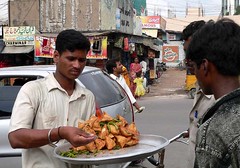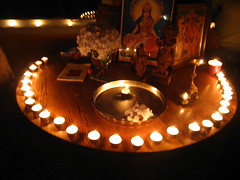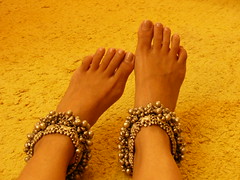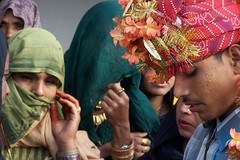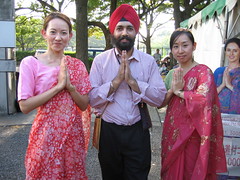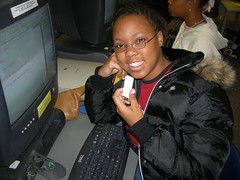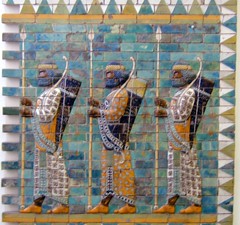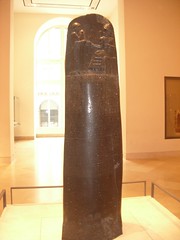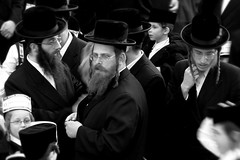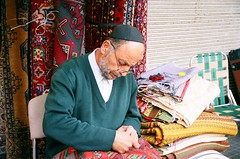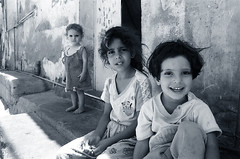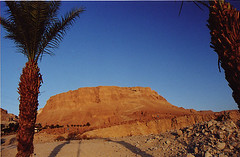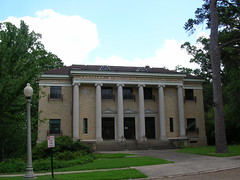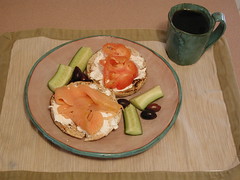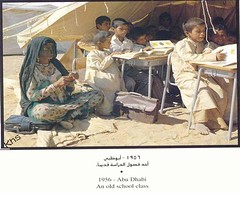Find the significant . . .
3 bodies of water
2 rivers: the Indus, in Pakistan, and the holy Ganges, flowing East near Kolkata.
4 cities
5 neighbors
1 mtn range
2 peaks: Mt Everest and K2, near the Pakistani-China border.
Tuesday, October 31, 2006
Anoushka Shankar and father, the sitar master Ravi Shankar
Ravi Shankar is a legend of 2oth century music for his many performances on sitar. He has 2 daughters who are also notable musical figures: Anoushka Shankar, sitarist, and singer Norah Jones.
The sitar is long-necked lute (sometimes 4 feet in length).
- 7 plucked strings, 12 sympathetic and drone strings.
ravi is considered a guru of sitar performance.
The sitar is long-necked lute (sometimes 4 feet in length).
- 7 plucked strings, 12 sympathetic and drone strings.
ravi is considered a guru of sitar performance.
Connections with India in our future
Why India will be a bigger part of American life in the future:
1) Pop. growth: will become more populous than China.
2) Migration to the US (brain drain); an increasing number of your classmates and neighbors will be of Indian background.
3) Outsourcing of jobs to India. See Microsoft office in Hyderabad, above. Dell also has a large division in India, says the NYT.
4) US international politics - we need a stronger relationship with India to balance our influence in South Asia.
5) Yoga is growing in influence as Americans try to cope with stress and fitness issues.
In the 1960's and 70's the Beatles and Led Zeppelin visited India and drew the world's attention to the gurus and sitar music. The Nehru jacket became popular. So did Indian sandals, kurtas, jewelry and statues of Hindu gods. Jimi Hendrix' 2nd album used Hindu gods on the album cover. Ravi Shankar, sitarist, became widely known.
1) Pop. growth: will become more populous than China.
2) Migration to the US (brain drain); an increasing number of your classmates and neighbors will be of Indian background.
3) Outsourcing of jobs to India. See Microsoft office in Hyderabad, above. Dell also has a large division in India, says the NYT.
4) US international politics - we need a stronger relationship with India to balance our influence in South Asia.
5) Yoga is growing in influence as Americans try to cope with stress and fitness issues.
In the 1960's and 70's the Beatles and Led Zeppelin visited India and drew the world's attention to the gurus and sitar music. The Nehru jacket became popular. So did Indian sandals, kurtas, jewelry and statues of Hindu gods. Jimi Hendrix' 2nd album used Hindu gods on the album cover. Ravi Shankar, sitarist, became widely known.
Sunday, October 29, 2006
Bus trip to Stoner Elementary to teach 4th graders in each class hour on Mon, Oct 30
Field trip permission slips were given to each student last week for the brief trip to Stoner Elementary to be taken in each class period Mon, Oct 30. Sixth hour students have been invited to go to with either period 1, 2 3 or 4.
Students prepared and presented their teaching packages last week. Units are on the war in Iraq or the background of historic Iraq, Mesopotamia
Students prepared and presented their teaching packages last week. Units are on the war in Iraq or the background of historic Iraq, Mesopotamia
Friday, October 27, 2006
Gandhi and the US / Map quiz Tues., Open notes on Thurs.
A soulful connection betwwen India and the US . . .
Mohandas Karamchand Gandhi, the Mahatma, or Great Soul -
1869 -1948
Raised in Porbandor, India, on Arabian Sea.
Led movement to free India from British Colonial rule.
30 years of leading demonstrations and being jailed.
Also fought against
- caste system
- Hindu-Muslim conflict.
- His agenda was emulated by Martin Luther King, Jr, in the US Civil Rights movement. King used a wide array of techniques established by Gandhi:
* civil disobedience
* non-violence
* Christian principles
* innovative demonstrations
* use of the media
* use of the courts.
Both men were victims of assassination by extremists (fanatics, radicals).
********
* Map of India quiz Tuesday.
12 items between neighbors, landmarks, cities & bodies of water.
* India open notes quiz on Thurs.
************
Aryans brought the Sanskrit language and caste system to India about 2000 BC. The word "swastika" is Sanskrit. It means “good fortune.” It is a common symbol of ancient China, India and the tribes of Native America. In the early 1900's it was used in Germany by nationalist groups. Hitler used it because it tied in with the Aryan connection in his propaganda campaign.
dhoti - basic man’s skirt of working class India.
The cuisine of India:
Dylan Zepeda and Kaitlin Williams recently brought delicious dishes to class.
- Garam masala chicken was made by Kaitlin and her mom. It was made with the spicy masala mixture and yogurt.
- Samosas were made by Dylan and his father. A spicy ground meat mixture is wrapped in puff pastry to make the popular treat.
Which is more complex, the spicy cooking of India or that of Creole and Cajun cooks?
******
Independent work:
* Research & compare the lives of Gandhi and Hitler.
* R & c a garam masala and an etouffee.
* R & c the regions of Kashmir and the Punjab.
* R & c the cities of Mumbai and NYC.
* R & c the colonial rule of India and the US.
**********
Sunni and Shi’a differences are based on how the Muslim community decided to name the successor to the Prophet Muhammad. The Sunni felt that election from among powerful leaders was good. The Shi’a felt that relatives of the Prophet should be favored.
*********
Mohandas Karamchand Gandhi, the Mahatma, or Great Soul -
1869 -1948
Raised in Porbandor, India, on Arabian Sea.
Led movement to free India from British Colonial rule.
30 years of leading demonstrations and being jailed.
Also fought against
- caste system
- Hindu-Muslim conflict.
- His agenda was emulated by Martin Luther King, Jr, in the US Civil Rights movement. King used a wide array of techniques established by Gandhi:
* civil disobedience
* non-violence
* Christian principles
* innovative demonstrations
* use of the media
* use of the courts.
Both men were victims of assassination by extremists (fanatics, radicals).
********
* Map of India quiz Tuesday.
12 items between neighbors, landmarks, cities & bodies of water.
* India open notes quiz on Thurs.
************
Aryans brought the Sanskrit language and caste system to India about 2000 BC. The word "swastika" is Sanskrit. It means “good fortune.” It is a common symbol of ancient China, India and the tribes of Native America. In the early 1900's it was used in Germany by nationalist groups. Hitler used it because it tied in with the Aryan connection in his propaganda campaign.
dhoti - basic man’s skirt of working class India.
The cuisine of India:
Dylan Zepeda and Kaitlin Williams recently brought delicious dishes to class.
- Garam masala chicken was made by Kaitlin and her mom. It was made with the spicy masala mixture and yogurt.
- Samosas were made by Dylan and his father. A spicy ground meat mixture is wrapped in puff pastry to make the popular treat.
Which is more complex, the spicy cooking of India or that of Creole and Cajun cooks?
******
Independent work:
* Research & compare the lives of Gandhi and Hitler.
* R & c a garam masala and an etouffee.
* R & c the regions of Kashmir and the Punjab.
* R & c the cities of Mumbai and NYC.
* R & c the colonial rule of India and the US.
**********
Sunni and Shi’a differences are based on how the Muslim community decided to name the successor to the Prophet Muhammad. The Sunni felt that election from among powerful leaders was good. The Shi’a felt that relatives of the Prophet should be favored.
*********
Tuesday, October 24, 2006
Prince Siddhartha Gautama and his Enlightenment
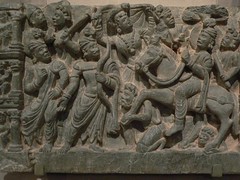
Prince Siddhartha Leaves His Palace The Great Departure Stone 2nd to 3rd century CE Gandhara Pakistan
Originally uploaded by mharrsch.
Siddhartha Gautama was born in India near the border with Nepal. His legend is the most famous embodiment of the story of Buddha and the beginning of Buddhism.
- Born a prince to a wealthy father who banished all illness, poverty and mortality from the kingdom so as to shield his son.
- Grew up handsome and intelligent. Met and married a beautiful woman of the court.
- Was continually troubled by a void in his soul.
- Began his quest to find what was missing in his life by leaving family and wealth.
- Became a sadhu and devoted himself to severe abstinence.
- While meditating under a Bodhi tree, experiences an epiphany, or enlightenment.
- Realized he should follow a Middle Way, not extreme devotion.
The Four Noble Truths of Buddhism:
* Life is about suffering.
* Suffering is caused by desire.
* The goal of a noble person is cessation of desire.
* Cessation of desire will follow from the Eightfold path:
right view, right intention, right speech, right action, right livelihood, right effort, right mindfulness, right concentration.
Today there are few Buddhists in India. Most are in China, Japan, Thailand and other East Asian nations. India is a land of Muslims and Hindus.
And, yes, there are many similarities between Hinduism and Buddhism.
Independent work:
Research & compare Hinduism and Buddhism.
Reeta Karmakar, Utsav Restaurant, Shreveport
Utsav, contemporary Indian cooking
8660 Fern Avenue Shreveport, LA • 71105
Phone: (318) 629-0726
Daily Lunch Buffet $9.95
Utsav Lunch Selections $11.95
Malai Kofta; Saag Paneer; Navratan Korma; Vegetable Jalfrezi; Chicken Curry; Lamb Curry; Chicken Tikka; Fish Curry
India, a land of mythology and celebration, of legend, religion and tradition has evolved over centuries as a mystic land of festival. Utsav means "celebrate." Every occasion you can dream of is celebrated with enthusiasm.
Lunch Tuesday through Friday: 11 a.m. to 2 p.m.
Lunch Saturday and Sunday: 11 a.m. to 3 p.m.
Dinner Tuesday through Friday: 5:30 p.m. to 9:30 p.m.
Dinner Friday and Saturday: 5:30 p.m. to 10:30 p.m.
Happy Hour: Tuesday - Friday 4 p.m. to 7 p.m. featuring 2 for 1 frozen drinks.
Take out and Dine in or catering is available.
We accept reservations.
For independent work students may write a descriptive essay - be specific - about their meal at Utsav. Include what you learn from the menu, decor and knowledgable people.
8660 Fern Avenue Shreveport, LA • 71105
Phone: (318) 629-0726
Daily Lunch Buffet $9.95
Utsav Lunch Selections $11.95
Malai Kofta; Saag Paneer; Navratan Korma; Vegetable Jalfrezi; Chicken Curry; Lamb Curry; Chicken Tikka; Fish Curry
India, a land of mythology and celebration, of legend, religion and tradition has evolved over centuries as a mystic land of festival. Utsav means "celebrate." Every occasion you can dream of is celebrated with enthusiasm.
Lunch Tuesday through Friday: 11 a.m. to 2 p.m.
Lunch Saturday and Sunday: 11 a.m. to 3 p.m.
Dinner Tuesday through Friday: 5:30 p.m. to 9:30 p.m.
Dinner Friday and Saturday: 5:30 p.m. to 10:30 p.m.
Happy Hour: Tuesday - Friday 4 p.m. to 7 p.m. featuring 2 for 1 frozen drinks.
Take out and Dine in or catering is available.
We accept reservations.
For independent work students may write a descriptive essay - be specific - about their meal at Utsav. Include what you learn from the menu, decor and knowledgable people.
Kanak, physician and proprietor of India's Restaurant, Shreveport
India's Restaurant is open every day, says the web site
sportindiasrestaurant.com. There you can visit the menus, too.
The lunch buffet - more or less all you can eat - is from 11 nto 2:30, or until 3 on weekends.
Dinner is 5:30 to 10 pm, 10:30 on weekends.
It is located north of the corner of King's and Youree on the service road, west side of Youree.
868-7761
Students may write a descriptive essay on the food, menu and ambience at an Indian restaurant for independent work.
English words that originate in the language of Hindi
English words derived from Hindi via the British, who controlled India as a colony for some 300 years (a selected list):
bangle
bandana
bazaar
bungalow
chai
cot
cummerbund
guru
jodhpurs
jungle
nirvana
pajamas
shampoo
thug
Historic India (Time-Life), Wikipedia.org
Monday, October 23, 2006
Diwali, Hindu festival of lights
Diwali: the Hindu festival of lights.
* dancing
* candles, fireworks.
* food, prayer, dance.
* dancing
* candles, fireworks.
* food, prayer, dance.
Silver Payals, anklets of traditional Indian style
Anklets, toe rings, nose piercings, henna tattoos, midriff garments: the ancient costumes and accents of India have been influential across the world. Youth culture today seems to be much inspired by Hindu style.
Indian bride with elaborate bindi - forehead decoration
Bindi is the dot or red spot on the forehead of a Hindu. Once it indicated that the person had done puja, prayer or sacrifice, for the day. Today the bindi is simply a decorative accent.
The cuisine of India: curry powder
Curry powder is a typical and well-known part of India’s cuisine. Curry contains, typically, a dozen spices. Among them:
cumin
coriander
fenugreek
ginger
dill seed
black pepper
red pepper
turmeric
cardamom
mace
cloves
We sniffed the characteristic sweet & hot aroma of curry in the classroom from a Spice Islands bottle of curry powder.
cumin
coriander
fenugreek
ginger
dill seed
black pepper
red pepper
turmeric
cardamom
mace
cloves
We sniffed the characteristic sweet & hot aroma of curry in the classroom from a Spice Islands bottle of curry powder.
≈ Aum ~ Om ≈
Sanskrit - an ancient language of India.
Om - the sound of all sounds.
Aum (also Om, ) is the most sacred syllable in Hinduism, symbolizing the infinite Brahman and the entire Universe.
Also, an example of a henna tattoo.
Most of the world farms for a living and remain impoverished
Subsistence farming comes from the term subsist, which means to survive. Most of the wold’s people are engaged in subsistence farming.
Millions of Muslims remain In India, despite the inevitable conflict with Hindus
India is a vast nation - over 900 million people - with 2 dominant sects: Hinduism and Islam. They are often antagonistic and violent toward one another.
Some 60 years ago two gigantic chunks of India were partititoned as a home to Muslims. They were Pakistan and Bangladesh. Yet millions of Muslims remain in India.
Sadhus near Pashupastinath
India is a nation where holy men are a common sight.
Called a sadhu, fakir or yogi, they are men who give up worldly goods (typically they own little more than a beggar’s bowl and staff) and pleasures (little food, no sex, no drink). Their occupation is begging and praying. Some use self-mortification - such as sitting on a bed of nails - as an additional pathway to holiness.
Namaste'! In Hindi, quite similar to Ni Hau, Salaam, Shalom, Ciao
Namaste’ - Hindi greeting which means, acc to wikipedia,
• The Spirit in me meets the same Spirit in you.
• I greet that place where you and I are one.
• I salute the Light of God in you.
• I bow to the divine in you.
• I recognize that within each of us is a place where Divinity dwells, and when we are in that place, we are One.
• My higher energy salutes your higher energy.
• the God in me sees and honors the god in you.
Sunday, October 22, 2006
Oct 23 - 27: Complete Mesopotamian/Iraqi Teaching Project as homework
Tentatively geo students will teach their Mesopotamian unit or lessons on the War in Iraq to students at Stoner Elementary on Mon, Oct 30. I'm waiting for confirmation of the bus arrangements. Classes will bus to and from Stoner Elem during the class hour, thus no classes will be missed. Our pupils will be either 4th or 5th graders, says Mrs. Martha Anderson, Stoner Elem. Coordinator.
Deadline for the 25 pt. project, however, is Thur, Oct 26. Students will lose 10 pts per day if late. All were given an explanatory check list in class Friday.
Mon.
Intro to India and neighbors Afghanistan, Pakistan & Bangladsesh -
what is the relationship between the Middle East and Central Asia?
Demographics.
Tue.
Hindu and Muslim culture and the continuing conflicts. Intro to Mohandas K. Gandhi.
Wed. The Taj Mahal, a blend of Islamic, Persian and Indian design. Mumtaz Mahal and the Shah Jahan.
Thur.
Scoring of the Teaching Unit. Brief presentations of the package from each student.
Fri.
Intro to Hindu mythology and the music of India.
Deadline for the 25 pt. project, however, is Thur, Oct 26. Students will lose 10 pts per day if late. All were given an explanatory check list in class Friday.
Mon.
Intro to India and neighbors Afghanistan, Pakistan & Bangladsesh -
what is the relationship between the Middle East and Central Asia?
Demographics.
Tue.
Hindu and Muslim culture and the continuing conflicts. Intro to Mohandas K. Gandhi.
Wed. The Taj Mahal, a blend of Islamic, Persian and Indian design. Mumtaz Mahal and the Shah Jahan.
Thur.
Scoring of the Teaching Unit. Brief presentations of the package from each student.
Fri.
Intro to Hindu mythology and the music of India.
Friday, October 20, 2006
Checklist for Stoner Elem Teaching Project
Sharing what we know with others is a CMHS theme
Teaching lesson for 4th & 5th graders at Stoner Elementary / Trudeau
Tentatively the visit will take place - by school bus - Mon, Oct 30, during the class hour.
Project is due Th, Oct 26. All typed. Total 25 pts.
choose one topic / theme:
1) Mesopotamia 2) War in Iraq
a) 3 lesson pages: one large colorful image on a page with 3 items of explanation. Vocabulary! 9 points.
Neatness! spelling!
b) Hands-on activity; ex, cuneiform vs hieroglyphics or a clay pinch pot. 3 pts
c) Colorful puzzle map: 8 labels with symbols, such as national flag. 5 pts Neatness! Borders; spelling!
d) Pre and post-lesson quiz of 5 mult-choice questions.
5 pts.
e) Student profile question sheet. 2 pts
f) Envelope or baggie so as not to lose map symbols.
g) Documentation! Titling! 3 pts.
Latitude & longitude is a grade level expectation we need to include in our plans.
*************
Independent work -
* Research and compare Cuneiform and Arabic writing.
* " " " the Ziggurat and the Aztec or Mayan temples.
* " " " the development of the wheel in Mesopotamia and in ancient China.
* " " " clothing, jewelry and hair styles as seen in ancient art of Mesopotamia and China.
4th grade Objectives
1. Draw, complete, or add features to a map (including such map elements
as a title, compass rose, legend, and scale), based on information given in
narrative form. (G-1A-E3)
2. Describe how physical and human characteristics (e.g., clothing, jobs,
shelter, modes of travel, and tools) have changed since colonial times.
(G-1B-E3)
3. Explain physical and human developments in a region since it was first
settled, based on given information. (G-1B-E3)
4. Develop or complete a timeline based on information given in a passage.
(H-1A-E1)
5. Interpret data presented in a timeline. (H-1A-E1)
6. Discuss historical events in chronological order based on information in a
timeline or given text. (H-1A-E1)
7. Describe the past in contrast to the present. (H-1A-E1)
8. Describe family life at a given time in history (e.g., early America) or
compare present-day family life with family life in a past time—e.g.,
homes, jobs, schooling, dress, customs, housekeeping, recreation,
transportation, communication, etc. (H-1B-E1)
9. Explain change or continuity over time (e.g., explain how a society has
changed over a given period of time based on information in stimulus
material). (H-1A-E2)
10. Contrast the viewpoints of people living in an earlier time to the
perspective of people today. (H-1A-E2)
11. Identify or describe early settlers in America (e.g., Pilgrims) and early
settlers in Louisiana (e.g., French, Spanish, Acadians). (H-1C-E1)
Wednesday, October 18, 2006
Do US government officials know the cultures where we're sending young Americans to fight a war? Sadly, no.
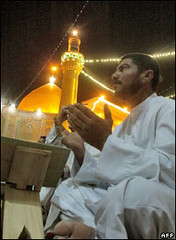
An Iraqi Shia Muslim prays at Imam Ali's shrine in the holy city of Najaf as Shias prepare to mark the anniversary of Imam Ali's martyrdom
Originally uploaded by johnhanscom.
Can You Tell a Sunni From a Shiite?
By JEFF STEIN
Washington / NY Times, oct 17, 06
FOR the past several months, I’ve been wrapping up lengthy interviews with Washington counterterrorism officials with a fundamental question: “Do you know the difference between a Sunni and a Shiite?”
A “gotcha” question? Perhaps. But if knowing your enemy is the most basic rule of war, I don’t think it’s out of bounds. And as I quickly explain to my subjects, I’m not looking for theological explanations, just the basics: Who’s on what side today, and what does each want?
After all, wouldn’t British counterterrorism officials responsible for Northern Ireland know the difference between Catholics and Protestants? In a remotely similar but far more lethal vein, the 1,400-year Sunni-Shiite rivalry is playing out in the streets of Baghdad, raising the specter of a breakup of Iraq into antagonistic states, one backed by Shiite Iran and the other by Saudi Arabia and other Sunni states.
A complete collapse in Iraq could provide a haven for Al Qaeda operatives within striking distance of Israel, even Europe. And the nature of the threat from Iran, a potential nuclear power with protégés in the Gulf states, northern Saudi Arabia, Lebanon and the Palestinian territories, is entirely different from that of Al Qaeda. It seems silly to have to argue that officials responsible for counterterrorism should be able to recognize opportunities for pitting these rivals against each other.
But so far, most American officials I’ve interviewed don’t have a clue. That includes not just intelligence and law enforcement officials, but also members of Congress who have important roles overseeing our spy agencies. How can they do their jobs without knowing the basics?
My curiosity about our policymakers’ grasp of Islam’s two major branches was piqued in 2005, when Jon Stewart and other TV comedians made hash out of depositions, taken in a whistleblower case, in which top F.B.I. officials drew blanks when asked basic questions about Islam. One of the bemused officials was Gary Bald, then the bureau’s counterterrorism chief. Such expertise, Mr. Bald maintained, wasn’t as important as being a good manager.
A few months later, I asked the F.B.I.’s spokesman, John Miller, about Mr. Bald’s comments. “A leader needs to drive the organization forward,” Mr. Miller told me. “If he is the executive in a counterterrorism operation in the post-9/11 world, he does not need to memorize the collected statements of Osama bin Laden, or be able to read Urdu to be effective. ... Playing ‘Islamic Trivial Pursuit’ was a cheap shot for the lawyers and a cheaper shot for the journalist. It’s just a gimmick.”
Of course, I hadn’t asked about reading Urdu or Mr. bin Laden’s writings.
A few weeks ago, I took the F.B.I.’s temperature again. At the end of a long interview, I asked Willie Hulon, chief of the bureau’s new national security branch, whether he thought that it was important for a man in his position to know the difference between Sunnis and Shiites. “Yes, sure, it’s right to know the difference,” he said. “It’s important to know who your targets are.”
That was a big advance over 2005. So next I asked him if he could tell me the difference. He was flummoxed. “The basics goes back to their beliefs and who they were following,” he said. “And the conflicts between the Sunnis and the Shia and the difference between who they were following.”
O.K., I asked, trying to help, what about today? Which one is Iran — Sunni or Shiite? He thought for a second. “Iran and Hezbollah,” I prompted. “Which are they?”
He took a stab: “Sunni.”
Wrong.
Al Qaeda? “Sunni.”
Right.
AND to his credit, Mr. Hulon, a distinguished agent who is up nights worrying about Al Qaeda while we safely sleep, did at least know that the vicious struggle between Islam’s Abel and Cain was driving Iraq into civil war. But then we pay him to know things like that, the same as some members of Congress.
Take Representative Terry Everett, a seven-term Alabama Republican who is vice chairman of the House intelligence subcommittee on technical and tactical intelligence.
“Do you know the difference between a Sunni and a Shiite?” I asked him a few weeks ago.
Mr. Everett responded with a low chuckle. He thought for a moment: “One’s in one location, another’s in another location. No, to be honest with you, I don’t know. I thought it was differences in their religion, different families or something.”
To his credit, he asked me to explain the differences. I told him briefly about the schism that developed after the death of the Prophet Muhammad, and how Iraq and Iran are majority Shiite nations while the rest of the Muslim world is mostly Sunni. “Now that you’ve explained it to me,” he replied, “what occurs to me is that it makes what we’re doing over there extremely difficult, not only in Iraq but that whole area.”
Representative Jo Ann Davis, a Virginia Republican who heads a House intelligence subcommittee charged with overseeing the C.I.A.’s performance in recruiting Islamic spies and analyzing information, was similarly dumbfounded when I asked her if she knew the difference between Sunnis and Shiites.
“Do I?” she asked me. A look of concentration came over her face. “You know, I should.” She took a stab at it: “It’s a difference in their fundamental religious beliefs. The Sunni are more radical than the Shia. Or vice versa. But I think it’s the Sunnis who’re more radical than the Shia.”
Did she know which branch Al Qaeda’s leaders follow?
“Al Qaeda is the one that’s most radical, so I think they’re Sunni,” she replied. “I may be wrong, but I think that’s right.”
Did she think that it was important, I asked, for members of Congress charged with oversight of the intelligence agencies, to know the answer to such questions, so they can cut through officials’ puffery when they came up to the Hill?
“Oh, I think it’s very important,” said Ms. Davis, “because Al Qaeda’s whole reason for being is based on their beliefs. And you’ve got to understand, and to know your enemy.”
It’s not all so grimly humorous. Some agency officials and members of Congress have easily handled my “gotcha” question. But as I keep asking it around Capitol Hill and the agencies, I get more and more blank stares. Too many officials in charge of the war on terrorism just don’t care to learn much, if anything, about the enemy we’re fighting. And that’s enough to keep anybody up at night.
Jeff Stein is the national security editor at Congressional Quarterly.
The US in Iraq: enemies as elusive as sand
Notes from the wikipedia.org update on the US-Iraq invasion and occupation:
- coalition: mainly US & UK.
- new Iraqi army
- Shi'a vs. Sunni minority.
- insurgents, or rebels loyal to the Hussein's regime.
- 3000 US soldiers dead.
War rationale -
- threat to US interests in the region (oil).
- future effectiveness of US influence.
- UN sanctions against Iraq after '91 Gulf War.
- biological & chemical weapons.
- UNSCOM to destroy WMD, inspect.
- Iraq Liberation act of 98 / signed by Pres Clinton.
- Saddam praised 9-11 attacks.
- GWB: wmd, human rights violations, terrorism, SCUD missles, UN Oil-for-food, UN inspectors.
- Hans Blix, UN inspector: "not enough"
- 03 threat by Bush.
- $20 billion rebuilding promised by US against future oil revenue.
- worst violence in Baghdad, Basra, Fallujah.
- Sunni insurgency.
- insurgents' Mahdi Army strong.
Human rights abuses on all sides -
- US at Abu Ghraib prison.
- scattered attacks on Iraqui citizens.
Insurgent forces -
- murder of Iraquis, some 12,000.
- bombings, beheadings and torture.
- coalition: mainly US & UK.
- new Iraqi army
- Shi'a vs. Sunni minority.
- insurgents, or rebels loyal to the Hussein's regime.
- 3000 US soldiers dead.
War rationale -
- threat to US interests in the region (oil).
- future effectiveness of US influence.
- UN sanctions against Iraq after '91 Gulf War.
- biological & chemical weapons.
- UNSCOM to destroy WMD, inspect.
- Iraq Liberation act of 98 / signed by Pres Clinton.
- Saddam praised 9-11 attacks.
- GWB: wmd, human rights violations, terrorism, SCUD missles, UN Oil-for-food, UN inspectors.
- Hans Blix, UN inspector: "not enough"
- 03 threat by Bush.
- $20 billion rebuilding promised by US against future oil revenue.
- worst violence in Baghdad, Basra, Fallujah.
- Sunni insurgency.
- insurgents' Mahdi Army strong.
Human rights abuses on all sides -
- US at Abu Ghraib prison.
- scattered attacks on Iraqui citizens.
Insurgent forces -
- murder of Iraquis, some 12,000.
- bombings, beheadings and torture.
Tuesday, October 17, 2006
Israel & Arabia test
I s r a e l & A r a b i a / T r u d e a u
1. In Jerusalem this landmark lies south of the Church of the Holy Sepulcher and the Dome of the Rock as well as between them. a) Western Wall b) Via Dolorosa c) Citadel d) Damascus Gate.
2. He is thought of as the man who bridges the monotheistic religions: a) Jesus of Nazareth b) Abraham c) Prophet Muhammad d) King David.
3. This man is believed to have ascended into heaven from Jerusalem. a) Jesus of Nazareth b) Abraham c) Prophet Muhammad d) King David.
4. Unlike many of the world’s notable cities, Jerusalem is not located on a river. Over the centuries traders have had to depend on the city’s harbors on the Mediterranean Sea. T / F
5. Jerusalem is a city in which people observe _ sabbaths. a) 2 b) 3 c) 4 d) 5.
6. This region has been visited by the Holy Family, Lawrence of Arabia, Moses and numerous bandits: a) Negev Desert b) West Bank c) Nafud Desert d) Sinai Peninsula.
7. Syrup-soaked Middle Eastern pastry that is made from paper-thin sheets of phyllo dough and chopped nuts. a) Baklava b) Pita c) Hummus d) Tzatziki.
8. In Lawrence of Arabia the character Col. Brighton states why he thinks Great Britain is a great nation, though small in land, population and resources. It was a) Navy b) high-quality guns
c) brain power d) discipline.
9. In the desert the nomads make villages in dry canyons surrounded by rock walls. These places are called a) oases b) wadis c) dunes d) aquifers.
10. A permissible Jewish occupation in a Christian city:
a) usury b) slave trading c) scapegoat d) debtors.
11. Which of these sites is not a source but considered a portal, or entryway, into a world of sites referring to a particular topic? a) Yahoo.com b) Infoplease.com c) CIA.gov
d) Answers.com.
12. An exodus is similar to emigration, which is the same as a) dispersal b) immigration c) retribution d) extrication.
13. The pre-1948 name for today’s Israel: a) Palestine b) Lebanon c) Zion d) Ottoman Empire.
14. In chronological order: a) Judaism, Islam, Christianity
b) Christianity, Islam, Judaism c) Islam, Christianity, Judaism
d) Judaism, Christianity, Islam.
15. The Islamic feast of Rosh Hashanah is known as their New Year, or "head of the year," according to Wikipedia.org. No work may be done on Rosh Hashanah. T / F
16. What language has Lawrence learned, in addition to his mother tongue and French? a) Greek b) Arabic c) Hebrew d) Egyptian.
17. In Arabia there is a conflict between the tribal Bedouin peoples and the Turks. Their empire, which includes Arabia, is called the __ Empire.
a) Prussian b) Turkic c) Ottoman d) Egyptian.
18. In 1915 the top British priority in the Mid East was protection of a waterway important to their shipping and movement of warships.
a) Suez Canal b) Red Sea c) Arabian Sea d) Persian Gulf.
19. In the early 1900’s the city at the center of Islamic art, business and scholarship was not Mecca, nor Cairo. It was the capital of Syria. a) Damascus b) Beirut c) Medina d) Tel Aviv.
20. In the early phase of the movie Lawrence of Arabia the hero, TE Lawrence, resides in 3 nations. a) England, Egypt, Saudi Arabia b) England, Syria, Saudi Arabia c) England, Saudi Arabia, Israel d) England, Saudi Arabia, Iraq.
Photo above: a girl of Tel Aviv, Israel.
Sunday, October 15, 2006
Hammurabi
The Code of Hammurabi [18th Century BCE]
Of the several law codes surviving from the ancient Middle East, the most famous after the Hebrew Torah is the Code of Hammurabi, sixth king of the Amorite Dynasty of Old Babylon. It is best known from a beautifully engraved diorite stela now in the Louvre Museum which also depicts the king receiving the law from Shamash, the god of justice. This copy was made long after Hammurabi's time, and it is clear that his was a long-lasting contribution to Mesopotamian civil ization.
It encodes many laws which had probably evolved over a long period of time, but is interesting to the general reader because of what it tells us about the attitudes and daily lives of the ancient Babylonians. In the following selection, most of the long prologue praising Hammurabi's power and wisdom is omitted.
samples of the laws:
15: If any one take a male or female slave of the court, or a male or female slave of a freed man, outside the city gates [to escape], he shall be put to death.
16: If any one receive into his house a runaway male or female slave of the court, or of a freedman, and does not bring it out at the public proclamation of the [police], the master of the house shall be put to death.
53: If any one be too lazy to keep his dam in proper condition, and does not so keep it; if then the dam break and all the fields be flooded, then shall he in whose dam the break occurred be sold for money, and the money shall replace the [grain] which he has caused to be ruined.
54: If he be not able to replace the [grain], then he and his possessions shall be divided among the farmers whose corn he has flooded.
108: If a [woman wine-seller] does not accept [grain] according to gross weight in payment of drink, but takes money, and the price of the drink is less than that of the corn, she shall be convicted and thrown into the water. (1)
109: If conspirators meet in the house of a [woman wine-seller], and these conspirators are not captured and delivered to the court, the [wine-seller] shall be put to death.
110: If a "sister of a god"[nun] open a tavern, or enter a tavern to drink, then shall this woman be burned to death.
129: If a man's wife be surprised [having intercourse] with another man, both shall be tied and thrown into the water, but the husband may pardon his wife and the king his slaves.
130: If a man violate the wife (betrothed or child-wife) of another man, who has never known a man, and still lives in her father's house, and sleep with her and be surprised [caught], this man shall be put to death, but the wife is blameless.
131: If a man bring a charge against [his] wife, but she is not surprised with another man, she must take an oath and then may return to her house.
132: If the "finger is pointed" at a man's wife about another man, but she is not caught sleeping with the other man, she shall jump into the river for [the sake of her] husband. (2)
138: If a man wishes to separate from his wife who has borne him no children, he shall give her the amount of her purchase money and the dowry which she brought from her father's house, and let her go.
141: If a man's wife, who lives in his house, wishes to leave it, plunges into debt [to go into business], tries to ruin her house, neglects her husband, and is judicially convicted: if her husband offer her release, she may go on her way, and he gives her nothing as a gift of release. If her husband does not wish to release her, and if he take another wife, she shall remain as servant in her husband's house.
142: If a woman quarrel with her husband, and say: "You are not congenial to me," the reasons for her prejudice must be presented. If she is guiltless, and there is no fault on her part, but he leaves and neglects her, then no guilt attaches to this woman, she shall take her dowry and go back to her father's house. (3)
More at World Civilization Reader.
Of the several law codes surviving from the ancient Middle East, the most famous after the Hebrew Torah is the Code of Hammurabi, sixth king of the Amorite Dynasty of Old Babylon. It is best known from a beautifully engraved diorite stela now in the Louvre Museum which also depicts the king receiving the law from Shamash, the god of justice. This copy was made long after Hammurabi's time, and it is clear that his was a long-lasting contribution to Mesopotamian civil ization.
It encodes many laws which had probably evolved over a long period of time, but is interesting to the general reader because of what it tells us about the attitudes and daily lives of the ancient Babylonians. In the following selection, most of the long prologue praising Hammurabi's power and wisdom is omitted.
samples of the laws:
15: If any one take a male or female slave of the court, or a male or female slave of a freed man, outside the city gates [to escape], he shall be put to death.
16: If any one receive into his house a runaway male or female slave of the court, or of a freedman, and does not bring it out at the public proclamation of the [police], the master of the house shall be put to death.
53: If any one be too lazy to keep his dam in proper condition, and does not so keep it; if then the dam break and all the fields be flooded, then shall he in whose dam the break occurred be sold for money, and the money shall replace the [grain] which he has caused to be ruined.
54: If he be not able to replace the [grain], then he and his possessions shall be divided among the farmers whose corn he has flooded.
108: If a [woman wine-seller] does not accept [grain] according to gross weight in payment of drink, but takes money, and the price of the drink is less than that of the corn, she shall be convicted and thrown into the water. (1)
109: If conspirators meet in the house of a [woman wine-seller], and these conspirators are not captured and delivered to the court, the [wine-seller] shall be put to death.
110: If a "sister of a god"[nun] open a tavern, or enter a tavern to drink, then shall this woman be burned to death.
129: If a man's wife be surprised [having intercourse] with another man, both shall be tied and thrown into the water, but the husband may pardon his wife and the king his slaves.
130: If a man violate the wife (betrothed or child-wife) of another man, who has never known a man, and still lives in her father's house, and sleep with her and be surprised [caught], this man shall be put to death, but the wife is blameless.
131: If a man bring a charge against [his] wife, but she is not surprised with another man, she must take an oath and then may return to her house.
132: If the "finger is pointed" at a man's wife about another man, but she is not caught sleeping with the other man, she shall jump into the river for [the sake of her] husband. (2)
138: If a man wishes to separate from his wife who has borne him no children, he shall give her the amount of her purchase money and the dowry which she brought from her father's house, and let her go.
141: If a man's wife, who lives in his house, wishes to leave it, plunges into debt [to go into business], tries to ruin her house, neglects her husband, and is judicially convicted: if her husband offer her release, she may go on her way, and he gives her nothing as a gift of release. If her husband does not wish to release her, and if he take another wife, she shall remain as servant in her husband's house.
142: If a woman quarrel with her husband, and say: "You are not congenial to me," the reasons for her prejudice must be presented. If she is guiltless, and there is no fault on her part, but he leaves and neglects her, then no guilt attaches to this woman, she shall take her dowry and go back to her father's house. (3)
More at World Civilization Reader.
Mesopotamia
More ancient civilization than the Egyptians? Check out this site as an intriduction to Sumerian civilization and Mesopotamia: Mesopotamia unit.
It makes us a bit uncomfortable to know that these pioneers of city-building and law-giving are today governable only by a military dictator like Saddam Hussein. Time will tell whether as a nation they can adapt to something other than a totalitarian state.
Mon
Intro to Sumer and Ur.
Tues
Ziggurats
Wed
Hammurabi's code
Thurs
Library research on Sumer and Iraq.
Fri
Library research
It makes us a bit uncomfortable to know that these pioneers of city-building and law-giving are today governable only by a military dictator like Saddam Hussein. Time will tell whether as a nation they can adapt to something other than a totalitarian state.
Mon
Intro to Sumer and Ur.
Tues
Ziggurats
Wed
Hammurabi's code
Thurs
Library research on Sumer and Iraq.
Fri
Library research
Thursday, October 12, 2006
Dr Jana DeBenedetti blows the Jewish shofar at cmhs
Jewish studies were terrifically enhanced when Dr Jana DeBenedetti spoke to classes at Cmhs. "Dr J," a Magnet parent as well Hebrew scholar, as spoke to hours 2, 3 and 4. The theme that emerged from her explanations was the commonality of Judaism, islam and Christianity. She showed the classes Judaica: a shofar (ram's horn trumpet), 2 menorahs, talit (prayer shawl), yarmulke and other items.
In my notes:
Dr Jana DeBenedetti, 10-11
- Jewish symbol: 7 branched menorah / 8 plus 1 is the Hannuka menorah.
- Torah: 5 books mnemonic: “General Electric lights never dim.”
- Jewish congregations
Orthodox - strict observance of the ancient laws. Ex: Hassidim.
Conservative - moderate strictness.
Reform (liberal; most American Jews are Reform and do not follow kosher or attend the synagogue regularly).
Non-religious
Similarities between Arabic and Hebrew (ancient communication written w hammer & chisel, right to left)
- right to left
- no vowels
- similar sounds (shalom, salaam).
Sims between Islam and Judaism -
- dietary guidelines
- prayer
*bar (“son of”) mitzvah (“commandment”) or bat (“daughter”) mitzvah
- yarmulke, aka kippa
Kosher review -
- the word Unclean does not mean “dirty,” but means “taboo.”
- acceptable animals: chew their cud and have cloven hooves.
- slaughter must be by knife, followed by draining of blood and packing in salt (kosher salt - large flakes).
- not OK: pork, horse, cat, dog.
- no predator fowl.
- fish must have fins, scales (no catfish).
- no shellfish (oysters, clams, mussels)
- no crustaceans (crawfish, lobster, shrimp)
- separate dairy and meat in kitchen prep and in meals.
BC has another name: BCE - Before Common Era
AD also has another name: CE - Common Era, aka Anno Domini (year of our Lord)
3 different calendars: Jewish, Christian, Muslim.
Klezmer music - jazzy Jewish pop.
In my notes:
Dr Jana DeBenedetti, 10-11
- Jewish symbol: 7 branched menorah / 8 plus 1 is the Hannuka menorah.
- Torah: 5 books mnemonic: “General Electric lights never dim.”
- Jewish congregations
Orthodox - strict observance of the ancient laws. Ex: Hassidim.
Conservative - moderate strictness.
Reform (liberal; most American Jews are Reform and do not follow kosher or attend the synagogue regularly).
Non-religious
Similarities between Arabic and Hebrew (ancient communication written w hammer & chisel, right to left)
- right to left
- no vowels
- similar sounds (shalom, salaam).
Sims between Islam and Judaism -
- dietary guidelines
- prayer
*bar (“son of”) mitzvah (“commandment”) or bat (“daughter”) mitzvah
- yarmulke, aka kippa
Kosher review -
- the word Unclean does not mean “dirty,” but means “taboo.”
- acceptable animals: chew their cud and have cloven hooves.
- slaughter must be by knife, followed by draining of blood and packing in salt (kosher salt - large flakes).
- not OK: pork, horse, cat, dog.
- no predator fowl.
- fish must have fins, scales (no catfish).
- no shellfish (oysters, clams, mussels)
- no crustaceans (crawfish, lobster, shrimp)
- separate dairy and meat in kitchen prep and in meals.
BC has another name: BCE - Before Common Era
AD also has another name: CE - Common Era, aka Anno Domini (year of our Lord)
3 different calendars: Jewish, Christian, Muslim.
Klezmer music - jazzy Jewish pop.
Tuesday, October 10, 2006
Yiddish: German plus Hebrew script produces a rich addition to the English vocabulary
Yiddish (Yid. ייִדיש, yidish, = n. & adj. "Jewish") is a nonterritorial Germanic language spoken throughout the world and written with the Hebrew alphabet. It originated in the Ashkenazi culture that developed from about the 10th century in central and eastern Europe, and spread via emigration to other continents, says Wikipedia.
Yiddish-English words (What's not to enjoy?):
bagel : a ring-shaped bread roll made by boiling then baking the dough (from בײגל beygl)
blintz : a sweet cheese-filled crepe (from Yiddish בלינצע blintse)
chutzpah : ballsiness, guts, daring, audacity, effrontery (Yiddish חוצפּה khutspe, from Hebrew)
dybbuk : the malevolent spirit of a dead person which enters and controls a living body until exorcised (from Hebrew דיבוק dibbuk, that which clings)
dreck : (vulgar) worthless material, especially merchandise; "crap" (cf. German Dreck 'dirt')
glitch : a minor malfunction (possibly from Yiddish glitsh)
goy : a gentile, someone not of the Jewish faith or people (Yiddish גוי, plural גוים goyim; from Hebrew גוים goyim meaning 'nations [usually other than Israel]', plural of גוי goy 'nation')
kibitz : to offer unwanted advice, e.g. to someone playing cards; to converse idly, gossip (Yiddish קיבעצן kibetsn)
klutz : clumsy person (from Yiddish קלאָץ klots 'wooden beam')
kosher : conforming to Jewish dietary laws; (slang) appropriate, legitimate (originally from Hebrew כּשר kašer)
kvetch : to complain habitually, gripe; as a noun, a person who always complains (from Yiddish קװעטשן kvetshn 'press, squeeze')
latke : potato pancake, especially during Hanukkah (from Yiddish, from either Ukrainian or Russian)
lox : smoked salmon (from Yiddish לאַקס laks 'salmon'; cf. German Lachs 'salmon')
maven : expert (from Yiddish מבֿין meyvn, from Hebrew meveen 'one who understands')
Mazel tov : congratulations! (Yiddish מזל־טובֿ mazl-tov, from Hebrew mazzãl ṭõv: mazzãl 'luck' + ṭõv 'good')
mensch : an upright man; a decent human being (from Yiddish מענטש mentsh 'person', cf. German Mensch)
meshuga, also meshugge, meshugah, meshuggah : crazy (Yiddish משוגע meshuge, from Hebrew məšugga‘)
meshugas : madness, nonsense, irrational idiosyncrasy (Yiddish משוגעת meshugas, from Hebrew məšugga‘ath, a form of the above)
nebbish : an insignificant, pitiful person; a nonentity (from Yiddish nebekh 'poor thing!' [interjection])
nosh : snack (noun or verb) (Yiddish נאַשן nashn)
oy : interjection of surprise, dismay, or grief (Yiddish אױ oy)
oy vey : interjection of grief, pain, or horror (Yiddish אױ װײ oy vey 'oh, pain!')
putz : an idiot, a jerk; a penis (from Yiddish פּאָץ pots)
schlemiel : an inept clumsy person; a bungler; a dolt (Yiddish shlemil)
schlep : to drag or haul (an object); to make a tedious journey (from Yiddish שלעפּן shlepn; cf. German schleppen)
schlock : something cheap, shoddy, or inferior (perhaps from Yiddish shlak 'a stroke')
schmaltz : melted chicken fat; excessive sentimentality (from Yiddish שמאַלץ shmalts 'fat'; cf. German Schmalz)
schmeer also schmear : noun or verb: spread (e.g., cream cheese on a bagel); bribe (from Yiddish שמיר shmir 'smear'; cf. German schmieren)
schmo : a stupid person. (an alteration of schmuck; see below)
schmooze : to converse informally, make small talk or chat (from Yiddish שמועסן shmuesn 'converse'; cf. German schmusen).
The word has been somewhat popularised by Sir Alan Sugar (a Jew himself) on the BBC TV series The Apprentice.
schmuck : a contemptible or foolish person; a jerk; literally means 'penis' (from Yiddish שמאָק shmok 'penis')
schnook : an easily imposed-upon or cheated person, a pitifully meek person, a particularly gullible person (perhaps from Yiddish שנוק shnuk 'snout')
schnoz or schnozz also schnozzle : a nose, especially a large nose (perhaps from Yiddish שנויץ shnoits 'snout', cf. German Schnauze)
shiksa : (often derogatory) a young non-Jewish woman (Yiddish שיקסע shikse, a derivative of the above שײגעץ sheygets)
shtetl : a small town with a large Jewish population in pre-Holocaust Eastern Europe (Yiddish שטעטל shtetl 'town', diminutive of שטאָט shtot 'city')
shtick : comic theme; a defining habit or distinguishing feature (from Yiddish שטיק 'piece'; cf. German Stück)
spiel : a sales pitch or speech intended to persuade (from Yiddish שפּיל shpil 'play' or German Spiel 'play').
tchotchke or tsatske : knickknack, trinket, curio (from Yiddish טשאַטשקע tshatshke)
tush : butt, rear end (from tuchus)
Yekke : (mildly derogatory) a German Jew (Yiddish יעקע Yeke)
yenta : a talkative woman; a gossip; a scold (from Yiddish יענטע, from a given name)
zaftig : plump, chubby, full-figured (from Yiddish zaftik 'juicy'; cf. German saftig)
Yiddish-English words (What's not to enjoy?):
bagel : a ring-shaped bread roll made by boiling then baking the dough (from בײגל beygl)
blintz : a sweet cheese-filled crepe (from Yiddish בלינצע blintse)
chutzpah : ballsiness, guts, daring, audacity, effrontery (Yiddish חוצפּה khutspe, from Hebrew)
dybbuk : the malevolent spirit of a dead person which enters and controls a living body until exorcised (from Hebrew דיבוק dibbuk, that which clings)
dreck : (vulgar) worthless material, especially merchandise; "crap" (cf. German Dreck 'dirt')
glitch : a minor malfunction (possibly from Yiddish glitsh)
goy : a gentile, someone not of the Jewish faith or people (Yiddish גוי, plural גוים goyim; from Hebrew גוים goyim meaning 'nations [usually other than Israel]', plural of גוי goy 'nation')
kibitz : to offer unwanted advice, e.g. to someone playing cards; to converse idly, gossip (Yiddish קיבעצן kibetsn)
klutz : clumsy person (from Yiddish קלאָץ klots 'wooden beam')
kosher : conforming to Jewish dietary laws; (slang) appropriate, legitimate (originally from Hebrew כּשר kašer)
kvetch : to complain habitually, gripe; as a noun, a person who always complains (from Yiddish קװעטשן kvetshn 'press, squeeze')
latke : potato pancake, especially during Hanukkah (from Yiddish, from either Ukrainian or Russian)
lox : smoked salmon (from Yiddish לאַקס laks 'salmon'; cf. German Lachs 'salmon')
maven : expert (from Yiddish מבֿין meyvn, from Hebrew meveen 'one who understands')
Mazel tov : congratulations! (Yiddish מזל־טובֿ mazl-tov, from Hebrew mazzãl ṭõv: mazzãl 'luck' + ṭõv 'good')
mensch : an upright man; a decent human being (from Yiddish מענטש mentsh 'person', cf. German Mensch)
meshuga, also meshugge, meshugah, meshuggah : crazy (Yiddish משוגע meshuge, from Hebrew məšugga‘)
meshugas : madness, nonsense, irrational idiosyncrasy (Yiddish משוגעת meshugas, from Hebrew məšugga‘ath, a form of the above)
nebbish : an insignificant, pitiful person; a nonentity (from Yiddish nebekh 'poor thing!' [interjection])
nosh : snack (noun or verb) (Yiddish נאַשן nashn)
oy : interjection of surprise, dismay, or grief (Yiddish אױ oy)
oy vey : interjection of grief, pain, or horror (Yiddish אױ װײ oy vey 'oh, pain!')
putz : an idiot, a jerk; a penis (from Yiddish פּאָץ pots)
schlemiel : an inept clumsy person; a bungler; a dolt (Yiddish shlemil)
schlep : to drag or haul (an object); to make a tedious journey (from Yiddish שלעפּן shlepn; cf. German schleppen)
schlock : something cheap, shoddy, or inferior (perhaps from Yiddish shlak 'a stroke')
schmaltz : melted chicken fat; excessive sentimentality (from Yiddish שמאַלץ shmalts 'fat'; cf. German Schmalz)
schmeer also schmear : noun or verb: spread (e.g., cream cheese on a bagel); bribe (from Yiddish שמיר shmir 'smear'; cf. German schmieren)
schmo : a stupid person. (an alteration of schmuck; see below)
schmooze : to converse informally, make small talk or chat (from Yiddish שמועסן shmuesn 'converse'; cf. German schmusen).
The word has been somewhat popularised by Sir Alan Sugar (a Jew himself) on the BBC TV series The Apprentice.
schmuck : a contemptible or foolish person; a jerk; literally means 'penis' (from Yiddish שמאָק shmok 'penis')
schnook : an easily imposed-upon or cheated person, a pitifully meek person, a particularly gullible person (perhaps from Yiddish שנוק shnuk 'snout')
schnoz or schnozz also schnozzle : a nose, especially a large nose (perhaps from Yiddish שנויץ shnoits 'snout', cf. German Schnauze)
shiksa : (often derogatory) a young non-Jewish woman (Yiddish שיקסע shikse, a derivative of the above שײגעץ sheygets)
shtetl : a small town with a large Jewish population in pre-Holocaust Eastern Europe (Yiddish שטעטל shtetl 'town', diminutive of שטאָט shtot 'city')
shtick : comic theme; a defining habit or distinguishing feature (from Yiddish שטיק 'piece'; cf. German Stück)
spiel : a sales pitch or speech intended to persuade (from Yiddish שפּיל shpil 'play' or German Spiel 'play').
tchotchke or tsatske : knickknack, trinket, curio (from Yiddish טשאַטשקע tshatshke)
tush : butt, rear end (from tuchus)
Yekke : (mildly derogatory) a German Jew (Yiddish יעקע Yeke)
yenta : a talkative woman; a gossip; a scold (from Yiddish יענטע, from a given name)
zaftig : plump, chubby, full-figured (from Yiddish zaftik 'juicy'; cf. German saftig)
Israel: 12 questions based on the textbook's Ch 23
World Geo / Ch 23: Creating the Modern Middle East
1. The time of the Prophet Muhammad? a) 300 BC b) AD 300 c) 600 d) 1000.
2. Conquered by jihad and controlled by the Islamic Empire:
a) Iraq b) India c) France d) Greece.
3. People who broke up the Islamic Empire after somw 200 years:
a) Kurds b) Arabians c) Jews d) Turks.
4. The Ottoman Empire can be described as a) Christian & European b) Islamic & Persian c) Islamic & Turkish.
5. Why did the European nations desire control of the Mid Eastern nations (late 1800's, early 1900's), according to your textbook?
a) racism b) markets c) strategy d) ancient rivalry.
6. In WWI the Ottoman Turks were allied with
a) Germany b) France c) Britain d) Egypt.
7. “Over the centuries most Jews settled in other places.” That was the Jewish a) immigration b) diaspora c) holocaust d) Zionism.
8. Long term Jewish persecution in European nations prompted a back-to-Palestine movement called
a) self-determination b) oppression c) capitalism d) Zionism.
9. A movement of Jews away from Europe and back to Palestine began a) in the late 1800’s b) following the loss of 6 million Jews in the Nazi holocaust.
10. The proposal to divide Palestine into a Jewish half and Arab half was opposed by the Arabs in the 1940's. Their opposition was based on a) number of Arabs in Palestine (some 70%) vs the number of Jews (about 30%) b) emotional response to the incursion of Jews
c) ancient claims to the land based upon centuries of occupation.
11. “The UN voted to approve the partition of Palestine.” The word partition must mean to a) divide b) create walls c) form new wings and corridors d) build a foundation.
12. Since 1948 these people were “left with no country at all.” They are the a) Palestinians b) Jews c) Arabians d) Turks.
1. 600 AD
2. Iraq (Mesopotamia)
3. Turks
4. Islamic / Turkish
5. markets for their manufactured goods
6. Deutschland, or Germany
7. diaspora, or dispersal
8. Zionism (Zion being the ancient temple)
9. late 1800’s
10. proportion of Arabs to Jews, which at that time was majority Arab; today it’s about 85% Jewish
11. to divide
12. Palestinians; most of them live as refugees in neighboring nations.
1. The time of the Prophet Muhammad? a) 300 BC b) AD 300 c) 600 d) 1000.
2. Conquered by jihad and controlled by the Islamic Empire:
a) Iraq b) India c) France d) Greece.
3. People who broke up the Islamic Empire after somw 200 years:
a) Kurds b) Arabians c) Jews d) Turks.
4. The Ottoman Empire can be described as a) Christian & European b) Islamic & Persian c) Islamic & Turkish.
5. Why did the European nations desire control of the Mid Eastern nations (late 1800's, early 1900's), according to your textbook?
a) racism b) markets c) strategy d) ancient rivalry.
6. In WWI the Ottoman Turks were allied with
a) Germany b) France c) Britain d) Egypt.
7. “Over the centuries most Jews settled in other places.” That was the Jewish a) immigration b) diaspora c) holocaust d) Zionism.
8. Long term Jewish persecution in European nations prompted a back-to-Palestine movement called
a) self-determination b) oppression c) capitalism d) Zionism.
9. A movement of Jews away from Europe and back to Palestine began a) in the late 1800’s b) following the loss of 6 million Jews in the Nazi holocaust.
10. The proposal to divide Palestine into a Jewish half and Arab half was opposed by the Arabs in the 1940's. Their opposition was based on a) number of Arabs in Palestine (some 70%) vs the number of Jews (about 30%) b) emotional response to the incursion of Jews
c) ancient claims to the land based upon centuries of occupation.
11. “The UN voted to approve the partition of Palestine.” The word partition must mean to a) divide b) create walls c) form new wings and corridors d) build a foundation.
12. Since 1948 these people were “left with no country at all.” They are the a) Palestinians b) Jews c) Arabians d) Turks.
1. 600 AD
2. Iraq (Mesopotamia)
3. Turks
4. Islamic / Turkish
5. markets for their manufactured goods
6. Deutschland, or Germany
7. diaspora, or dispersal
8. Zionism (Zion being the ancient temple)
9. late 1800’s
10. proportion of Arabs to Jews, which at that time was majority Arab; today it’s about 85% Jewish
11. to divide
12. Palestinians; most of them live as refugees in neighboring nations.
Google purchases Youtube.com for a clearly exhorbitant sum of 1.6 billion
A profitless Web site started by three 20-somethings after a late-night dinner party is sold for more than a billion dollars, instantly turning dozens of its employees into paper millionaires. It sounds like a tale from the late 1990’s dot-com bubble, but it happened yesterday.
Larry Page, left, and Sergey Brin, two founders of Google, are hoping the profit potential of YouTube will outweigh the liability potential.
Big Bets, Uncertain Payoffs
Adding On to the House of Google (October 10, 2006)
Google, the online search behemoth, agreed yesterday to pay $1.65 billion in stock for the Web site that came out of that party — YouTube, the video-sharing phenomenon that is the darling of an Internet resurgence known as Web 2.0.
Larry Page, left, and Sergey Brin, two founders of Google, are hoping the profit potential of YouTube will outweigh the liability potential.
Big Bets, Uncertain Payoffs
Adding On to the House of Google (October 10, 2006)
Google, the online search behemoth, agreed yesterday to pay $1.65 billion in stock for the Web site that came out of that party — YouTube, the video-sharing phenomenon that is the darling of an Internet resurgence known as Web 2.0.
Monday, October 09, 2006
Zionism: return of the Jewish people to Palestine & the resulting conflict
In a skit I've created for geography class a group of students portray impoverished Arab shepherds - about the year 1935. The shepherds have lived on this land - topsoil denuded by their lack of knowlege in land usage - for centuries. Unbeknownst to them, official deeds to their land are actually held by officials of the Ottoman Empire. These men in Istanbul do not care about this virtually worthless land. Their ownership came along with the Ottoman's long-ago conquest of Palestine.
The other group of students portrays well-educated Jews from Europe. They are Zionists. The Zionist movement was created to seek a homeland for the Jews. Tired of centuries of abuse in European nations, Jews developed the Zionist movement in the late 1800's.
These men have raised money and come to buy the deeds to the land. They will then force most of the Arabs to leave so that a modern farm can be built. "Make the deserts bloom" is their famous battle cry.
After WWI the British controlled Palestine. Their solution to the problem of Palestinian Arab vs Jew was to ask both parties to share the nation.
Sadly, equal sharing is a rare thing in this world. In 1948 the Jews brought the skirmishes between themselves and the Arabs to a conclusion by militarily taking over Palestine. They proclaimed a new nation: Israel. It became a haven for displaced Jews from across the globe.
Most of the Arab peoples became refugees - fleeing to the neighboring nations of Lebanon and Jordan.
Since then the world has tried to force the Jews and Arabs to compromise on control of the territory in what was Palestine. Both sides have militant groups which have preferred to use violent retaliation as a tool. Suicide bombings were developed in this part of the world by militant Islamic groups.
Leaders of the Arab nations have been able to proclaim that the Jews must be driven into the sea to end the conflict.
The Israelis have survived by building a strong army and air force. Their weapons are supplied mostly by the US. Indeed, Israel gets more US aid each year than any nation, says Time magazine.
There is no end in sight to this conflict in the historic land where 3 great religions were founded.
- Zion: ancient site of the temple mount in Jerusalem. Zion means "rock," and is a symbolic word meaning temple or center of one's religion.
The other group of students portrays well-educated Jews from Europe. They are Zionists. The Zionist movement was created to seek a homeland for the Jews. Tired of centuries of abuse in European nations, Jews developed the Zionist movement in the late 1800's.
These men have raised money and come to buy the deeds to the land. They will then force most of the Arabs to leave so that a modern farm can be built. "Make the deserts bloom" is their famous battle cry.
After WWI the British controlled Palestine. Their solution to the problem of Palestinian Arab vs Jew was to ask both parties to share the nation.
Sadly, equal sharing is a rare thing in this world. In 1948 the Jews brought the skirmishes between themselves and the Arabs to a conclusion by militarily taking over Palestine. They proclaimed a new nation: Israel. It became a haven for displaced Jews from across the globe.
Most of the Arab peoples became refugees - fleeing to the neighboring nations of Lebanon and Jordan.
Since then the world has tried to force the Jews and Arabs to compromise on control of the territory in what was Palestine. Both sides have militant groups which have preferred to use violent retaliation as a tool. Suicide bombings were developed in this part of the world by militant Islamic groups.
Leaders of the Arab nations have been able to proclaim that the Jews must be driven into the sea to end the conflict.
The Israelis have survived by building a strong army and air force. Their weapons are supplied mostly by the US. Indeed, Israel gets more US aid each year than any nation, says Time magazine.
There is no end in sight to this conflict in the historic land where 3 great religions were founded.
- Zion: ancient site of the temple mount in Jerusalem. Zion means "rock," and is a symbolic word meaning temple or center of one's religion.
Sunday, October 08, 2006
Masada: fortress / desert site of siege of Jews by Romans
Masada (a romanization of the Hebrew מצדה, Metzada, from מצודה, metzuda, "fortress") is the name for a site of ancient palaces and fortifications in Israel on top of an isolated rock plateau on the eastern edge of the Judean Desert overlooking the Dead Sea. Masada became famous for its significance in the First Jewish-Roman War (Great Jewish Revolt), when a siege of the fortress by troops of the Roman Empire led to a mass suicide of the site's Jewish defenders when defeat became imminent.
Independent work . . .
Research & compare the Old Testament and the New Testament.
" " the Zionists and the Palestinian Liberation Organization (PLO).
" " the Roman army and the Jewish Zealots at Masada.
" " global demographics of Jews vs Muslims.
Guidelines for essays will help you gain the most points for your essay. Remember to integrate the documentation. Typically, you place it at the end of the first paragraph.
Independent work . . .
Research & compare the Old Testament and the New Testament.
" " the Zionists and the Palestinian Liberation Organization (PLO).
" " the Roman army and the Jewish Zealots at Masada.
" " global demographics of Jews vs Muslims.
Guidelines for essays will help you gain the most points for your essay. Remember to integrate the documentation. Typically, you place it at the end of the first paragraph.
Week of Oct 9 - 13: Open notes test Thur, guests, Judaica project
Oct 9
Mon
Judaica: the material objects of the Jewish culture, such as the menorah, star of David, Torah scroll, etc.
Tues
Egyptologist Dr. Bill Needles, special guest from his Revel hieroglyphics booth.
Wed
Rabbi & Hebrew teacher & author Dr. Jana DiBenedetti, on Jewish life.
Parents welcome to the lectures!
Thur
Open notes quiz: Israel, Jerusalem, etc
Fri
Images of Iraq from anitiquity: Mesopotamia, Ur, Sumer and the Code of Hammurabi.
End of 9 weeks.
Mon
Judaica: the material objects of the Jewish culture, such as the menorah, star of David, Torah scroll, etc.
Tues
Egyptologist Dr. Bill Needles, special guest from his Revel hieroglyphics booth.
Wed
Rabbi & Hebrew teacher & author Dr. Jana DiBenedetti, on Jewish life.
Parents welcome to the lectures!
Thur
Open notes quiz: Israel, Jerusalem, etc
Fri
Images of Iraq from anitiquity: Mesopotamia, Ur, Sumer and the Code of Hammurabi.
End of 9 weeks.
Friday, October 06, 2006
Write about a visit to the Karpeles Manuscript Library Museum; new exhibit on Biblical artifacts
Independent work: write a description of the best material seen in a visit to Karpeles Museum, corner of Centenary Blvd and Atkins St. (one block north of King's Hwy).
Says Times writer Diane Haag:
The history of Judaism and Christianity unfolds in documents and coins in the latest exhibit to open at Karpeles Manuscript Library Museum in Shreveport.
"The Bible," an exhibit that will be on display through December, sets out to show some historical proof behind the Scriptures that undergird two of the world's major religions.
"I hope they realize that it is very possible that the Bible is not a myth. The Bible is history," museum founder David Karpeles said. "We can't prove that for sure, but a lot of proof that leans that way."
Karpeles, a mathematician by training, acquired many of the manuscripts and artifacts by purchasing them from universities in the early 1980s. He rotates them in exhibits throughout the country. This particular exhibit is of special interest to Karpeles, who wrote his doctoral dissertation on "Biblical Historicity."
Shreveport's museum is the newest in the Karpeles network, and most of the others have already had the Bible exhibit. Director Lisa Tike is excited to bring it here. "The stuff I've seen so far is incredible," she said.
The exhibit starts with creation and ancient Sumerian tablets with pictograms that seem to tell a story of creation.
Noah and the flood figure prominently with pictures of a table that references Noah and the flood written about 2,000 B.C., long before the stories of Genesis were compiled. With the pictures are a tablet from the same time period that describes sacrifices to God.
The exhibit includes a replica of the first printed Ten commandments from the Gutenberg Bible. In the case next to it are pages from the first edition of the King James version of the Bible, one of which includes the Ten Commandments.
More at the Times Fri, Oct 6.
Free.
Fascinating former Christian Science temple.
Hours, etc.: 861- 7615
Says Times writer Diane Haag:
The history of Judaism and Christianity unfolds in documents and coins in the latest exhibit to open at Karpeles Manuscript Library Museum in Shreveport.
"The Bible," an exhibit that will be on display through December, sets out to show some historical proof behind the Scriptures that undergird two of the world's major religions.
"I hope they realize that it is very possible that the Bible is not a myth. The Bible is history," museum founder David Karpeles said. "We can't prove that for sure, but a lot of proof that leans that way."
Karpeles, a mathematician by training, acquired many of the manuscripts and artifacts by purchasing them from universities in the early 1980s. He rotates them in exhibits throughout the country. This particular exhibit is of special interest to Karpeles, who wrote his doctoral dissertation on "Biblical Historicity."
Shreveport's museum is the newest in the Karpeles network, and most of the others have already had the Bible exhibit. Director Lisa Tike is excited to bring it here. "The stuff I've seen so far is incredible," she said.
The exhibit starts with creation and ancient Sumerian tablets with pictograms that seem to tell a story of creation.
Noah and the flood figure prominently with pictures of a table that references Noah and the flood written about 2,000 B.C., long before the stories of Genesis were compiled. With the pictures are a tablet from the same time period that describes sacrifices to God.
The exhibit includes a replica of the first printed Ten commandments from the Gutenberg Bible. In the case next to it are pages from the first edition of the King James version of the Bible, one of which includes the Ten Commandments.
More at the Times Fri, Oct 6.
Free.
Fascinating former Christian Science temple.
Hours, etc.: 861- 7615
Using the Jerusalem Project on your classmates and family; 5 questions on the ancient walled city
Fri 10-06-06
Students use the Jerusalem project as a learning process across the campus. Having gotten my approval on their 5 questions, students will show project and quiz to adults and students and record the responses. Bonus credit may be earned Monday when a paragraph will be written evaluating the activity.
Friday's Test of quick recall on Israel and its neighbors.
* 12 items.
* Include the sea whose name means “middle” of the “earth,” or the water between 2 continents.
* Hand sketched borders; spelling, legibility.
**************
Jewish studies
Patriarchs in the 2000 - 1500 BC era: Abraham,
Moses, Joseph, Isaac, Jacob.
In the synagogue (or temple) you will find the Law of Moses, or Torah. It includes the books of Genesis (birth”), Exodus (“emigration”), Leviticus, Numbers and Deuteronomy.
Jewish foods:
- bagels & cream cheese & smoked salmon (lox)
- pita bread plus olive oil or yogurt.
**********
Thursday, October 05, 2006
Hand-sketched map of Israel Fri; write 5 mult-choice questions about Jerusalem
Jerusalem project presentations on Th, Oct 5, included:
a) Description of the city's elements - Dome of the Rock, etc.
b) Quote from your brief bio - so the class might try to name the famous figure being described.
c) Documentation - where you got your info.
- pronunciation of Church of the Holy Sepulchre (seh’ pul ker)
- do not use Google or Yahoo as a source. Those are internet portals, sites through which you go to get to the actual source.
Write 5 mult-choice questions to accompany your Jerusalem project. Try to write 2 easy, 1 medium difficulty, and 1 challenging. Put it on a page facing the Jerusalem project.
Worth 5 pts. When combined with notes on teaching Jerusalem as a lesson to a student or adult.
Arab dhow - graceful ship used in trade that spanned the Arabian Sea and Indian ocean. Traders traveled from India to Africa on dhows.
On sailing: lakes offer variable winds; they are almost constantly changing their direction and velocity. Coastal areas have comfortable, steady breezes.
- The physics of sailing into the wind are fascinating.
- Learning sailing: S’pt Yacht Club. See more at shreveyacht.com.
Guest speakers next week:
Tues. Egyptologist Dr. Bill Needles
Wed. Jewish studies expert Dr. Jana DeBenedetti; please see hebrewdoc.com
a) Description of the city's elements - Dome of the Rock, etc.
b) Quote from your brief bio - so the class might try to name the famous figure being described.
c) Documentation - where you got your info.
- pronunciation of Church of the Holy Sepulchre (seh’ pul ker)
- do not use Google or Yahoo as a source. Those are internet portals, sites through which you go to get to the actual source.
Write 5 mult-choice questions to accompany your Jerusalem project. Try to write 2 easy, 1 medium difficulty, and 1 challenging. Put it on a page facing the Jerusalem project.
Worth 5 pts. When combined with notes on teaching Jerusalem as a lesson to a student or adult.
Arab dhow - graceful ship used in trade that spanned the Arabian Sea and Indian ocean. Traders traveled from India to Africa on dhows.
On sailing: lakes offer variable winds; they are almost constantly changing their direction and velocity. Coastal areas have comfortable, steady breezes.
- The physics of sailing into the wind are fascinating.
- Learning sailing: S’pt Yacht Club. See more at shreveyacht.com.
Guest speakers next week:
Tues. Egyptologist Dr. Bill Needles
Wed. Jewish studies expert Dr. Jana DeBenedetti; please see hebrewdoc.com
Wednesday, October 04, 2006
Jewish studies: ancient map and prejudices
Jewish Studies
Ancient land of the Hebrews
1000 BC: 2 kingdoms - in the north, the Kingdom of Israel, and, in the south, the Kingdom of Judah (link to Judaism, Jew).
**********
The Wandering Jew is a phrase that describes an ancient stereotype of the Jew as someone searching for a peaceful home.
The Diaspora - dispersal of Jewish peoples - was significant during the Roman era. They left because the Romans treated them harshly. The Romans were moderate in their treatment of cooperative people. Rebellious kingdoms received violent retribution. The Jews were bitter toward the Romans and non-cooperative.
Jewish peoples emigrated to every corner of the globe, but most of them went to Europe. Nations famous for their influential Jewish populations were Italy, Spain, France, Germany and Russia.
Forced to live in the back of town, the Jews kept themselves generally separate from the Christians. No Jew would consider a marriage with a Christian. They lived in the ghetto, an Italian word for the Jewish Quarter.
Christians - including the Popes - encouraged mistrust and hatred of Jews. They blamed Jews for the death of Jesus (deicide) and opposed them for not accepting Jesus as Messiah.
From Wikipedia on anti-Semitism in the Middle Ages in Europe:
Among socio-economic factors were restrictions by the authorities, local rulers and frequently church officials who closed many professions to the Jews, pushing them into marginal occupations considered socially inferior, such as local tax and rent collecting or moneylending, seen in these times as a "necessary evil" due to the increasing population and urbanization during the High Middle Ages. Catholic doctrine of the time held that moneylending for interest was a sin, and as such Jews tended to dominate this business. The Torah and later sections of the Hebrew Bible criticise Usury but the Bible is slightly ambiguous. Jews were forced into money lending as there were few other occupations open to them. This provided support for claims that Jews are insolent, greedy, engaged in usury, and in itself contributed to a negative image. Natural tensions between creditors (typically Jews) and debtors (typically Christians) were added to social, political, religious and economic strains. Peasants who were forced to pay their taxes to Jews could personify them as the people taking their earnings while remaining loyal to the lords on whose behalf the Jews worked.
Today, usury means loaning money at exhorbitant interest.
Also:
As the Black Death epidemics devastated Europe in the mid-14th century, annihilating more than a half of the population, Jews were taken as scapegoats. Rumors spread that they caused the disease by deliberately poisoning wells. Hundreds of Jewish communities were destroyed by violence, in particular in the Iberic peninsula and in the Germanic Empire.
Torah, the Jews’ scripture - usually read from a traditional scroll.
Pogrom - murderous massacre of a Jewish community.
Don't forget the Old Jerusalem project Th, Oct 5.
Ancient land of the Hebrews
1000 BC: 2 kingdoms - in the north, the Kingdom of Israel, and, in the south, the Kingdom of Judah (link to Judaism, Jew).
**********
The Wandering Jew is a phrase that describes an ancient stereotype of the Jew as someone searching for a peaceful home.
The Diaspora - dispersal of Jewish peoples - was significant during the Roman era. They left because the Romans treated them harshly. The Romans were moderate in their treatment of cooperative people. Rebellious kingdoms received violent retribution. The Jews were bitter toward the Romans and non-cooperative.
Jewish peoples emigrated to every corner of the globe, but most of them went to Europe. Nations famous for their influential Jewish populations were Italy, Spain, France, Germany and Russia.
Forced to live in the back of town, the Jews kept themselves generally separate from the Christians. No Jew would consider a marriage with a Christian. They lived in the ghetto, an Italian word for the Jewish Quarter.
Christians - including the Popes - encouraged mistrust and hatred of Jews. They blamed Jews for the death of Jesus (deicide) and opposed them for not accepting Jesus as Messiah.
From Wikipedia on anti-Semitism in the Middle Ages in Europe:
Among socio-economic factors were restrictions by the authorities, local rulers and frequently church officials who closed many professions to the Jews, pushing them into marginal occupations considered socially inferior, such as local tax and rent collecting or moneylending, seen in these times as a "necessary evil" due to the increasing population and urbanization during the High Middle Ages. Catholic doctrine of the time held that moneylending for interest was a sin, and as such Jews tended to dominate this business. The Torah and later sections of the Hebrew Bible criticise Usury but the Bible is slightly ambiguous. Jews were forced into money lending as there were few other occupations open to them. This provided support for claims that Jews are insolent, greedy, engaged in usury, and in itself contributed to a negative image. Natural tensions between creditors (typically Jews) and debtors (typically Christians) were added to social, political, religious and economic strains. Peasants who were forced to pay their taxes to Jews could personify them as the people taking their earnings while remaining loyal to the lords on whose behalf the Jews worked.
Today, usury means loaning money at exhorbitant interest.
Also:
As the Black Death epidemics devastated Europe in the mid-14th century, annihilating more than a half of the population, Jews were taken as scapegoats. Rumors spread that they caused the disease by deliberately poisoning wells. Hundreds of Jewish communities were destroyed by violence, in particular in the Iberic peninsula and in the Germanic Empire.
Torah, the Jews’ scripture - usually read from a traditional scroll.
Pogrom - murderous massacre of a Jewish community.
Don't forget the Old Jerusalem project Th, Oct 5.
Monday, October 02, 2006
Wadi: a desert canyon
A wadi (Arabic وادي wādī) is a dry riverbed that contains water only during times of heavy rain, according to wikipedia.org. Compare arroyo (creek).
The term "Wadi" is very widely found in Arabic place names. Wadis tend to be associated with centers of human population because of the availability of sub-surface water.
Crossing wide wadis at certain times of the year can be very dangerous, because of unexpected flash floods. Such flash floods cause numerous deaths each year in Saudi Arabia and many other Middle Eastern countries.
The North African equivalent term is oued, although it is also used to refer to true rivers.
Some names of Spanish rivers are derived from Arabic names where "wadi" was used to mean a permanent river, for example Guadalquivir from (al) wādī al kabīr = "the big river".
The term "Wadi" is very widely found in Arabic place names. Wadis tend to be associated with centers of human population because of the availability of sub-surface water.
Crossing wide wadis at certain times of the year can be very dangerous, because of unexpected flash floods. Such flash floods cause numerous deaths each year in Saudi Arabia and many other Middle Eastern countries.
The North African equivalent term is oued, although it is also used to refer to true rivers.
Some names of Spanish rivers are derived from Arabic names where "wadi" was used to mean a permanent river, for example Guadalquivir from (al) wādī al kabīr = "the big river".
Connecting the British Triumph design to the Japanese Honda
The V-twin design of Harley Davidson has lasted in the marketplace, though the design is outmoded. The British vertical twin design, seen in the Triumph, BSA and Norton,
has lost favor. But the vertical twin design infleunced Japanese engineers such as Soichiro Honda. Their principal contribution to evolving technology is best seen in the Honda Cub, a 50 cc motor bike that is still being sold across the globe. It is cheap, fuel efficient, easy to repair and able to carry families or considerable loads. See the Honda Metropolitan scooter for the latest US version of the Cub 50.
has lost favor. But the vertical twin design infleunced Japanese engineers such as Soichiro Honda. Their principal contribution to evolving technology is best seen in the Honda Cub, a 50 cc motor bike that is still being sold across the globe. It is cheap, fuel efficient, easy to repair and able to carry families or considerable loads. See the Honda Metropolitan scooter for the latest US version of the Cub 50.
"What makes Britain great? Discipline, sir." Col. Brighton
What made Britain great? The Arabs in Lawrence of Arabia said "Its guns" and "Its Navy." But what made British firearms technology and ships and armed forces so effective? Indeed, Col. Brighton's answer, "discipline," seems a pretty good answer. British society was well-orderd in general and disciplined in education.
What has made the USA great? My answer is brainpower and creativity.
Geography student Shea Mighell said "Health and education." I agree. Good nutrition and schooling encourages the growth of brains. Look at the profiles of the creators of Google, Microsoft and Apple to gauge some of the reasons for America's success.
What has made the USA great? My answer is brainpower and creativity.
Geography student Shea Mighell said "Health and education." I agree. Good nutrition and schooling encourages the growth of brains. Look at the profiles of the creators of Google, Microsoft and Apple to gauge some of the reasons for America's success.
Sunday, October 01, 2006
Week of Oct 2 - 6: Jerusalem project due Thursday; Lawrence of Arabia; hand-sketched map of Israel test Fri
Oct 2
Mon.
5 Pillars of Islam - compare them to the 10 Commandments.
Abraham biography - see web site.
Tue.
Review of Lawrence of Arabia questions. Please see web site.
Brief bio of King David of Israel.
Wed.
Biography: Jesus of Nazareth.
Th.
Briefly present your annotated model of the Old City of Jerusalem.
Fr.
Lawrence of Arabia compared to Dwight D Eisenhower.
WWI leads to WWII.
Hand-sketched map of Israel (12 items plus borders; Med it e RR an Ean a required item)
Mon.
5 Pillars of Islam - compare them to the 10 Commandments.
Abraham biography - see web site.
Tue.
Review of Lawrence of Arabia questions. Please see web site.
Brief bio of King David of Israel.
Wed.
Biography: Jesus of Nazareth.
Th.
Briefly present your annotated model of the Old City of Jerusalem.
Fr.
Lawrence of Arabia compared to Dwight D Eisenhower.
WWI leads to WWII.
Hand-sketched map of Israel (12 items plus borders; Med it e RR an Ean a required item)
Subscribe to:
Comments (Atom)
